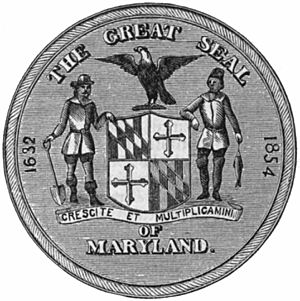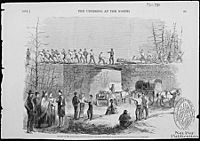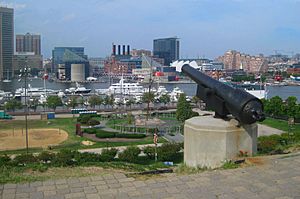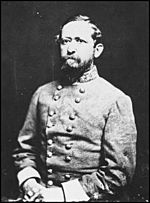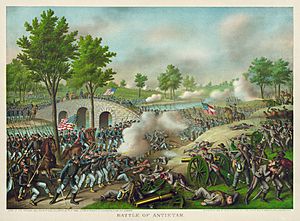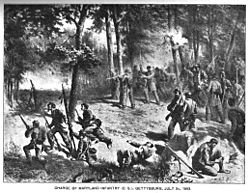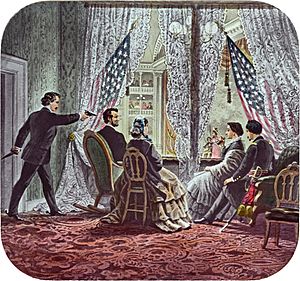Maryland in the American Civil War facts for kids
During the American Civil War (1861–1865), Maryland was a slave state located between the South and North. It was one of the border states, meaning it had slavery but stayed loyal to the Union. Even though some people in Maryland supported the Confederate States of America, the state did not leave the Union.
Maryland was very important in the war because it bordered Washington, D.C., the capital of the United States. Both sides wanted to control public opinion in the state. President Abraham Lincoln (who served from 1861–1865) took strong actions to keep Maryland in the Union. He even suspended a special legal right called habeas corpus (which protects people from being held without charges). This decision was challenged by Chief Justice Roger B. Taney, a Maryland native, but Lincoln did not follow his ruling.
The first deaths of the war happened in Maryland during the Baltimore Civil War Riots on April 19, 1861. Later, one of the bloodiest battles in American history, the Battle of Antietam, happened in Maryland on September 17, 1862. This battle was a key moment that allowed President Lincoln to issue the Emancipation Proclamation, which declared many enslaved people free.
In July 1864, the Battle of Monocacy was fought near Frederick, Maryland. This battle helped protect Washington, D.C., from a Confederate attack. About 50,000 Marylanders joined the military, with most fighting for the Union. A smaller number joined the Confederacy. Slavery was ended in Maryland in 1864, before the war officially ended. Sadly, Marylander John Wilkes Booth assassinated President Lincoln on April 14, 1865.
Contents
Maryland Before the War
Divided Loyalties in Maryland
Maryland was a slave-holding state, and its people had very different ideas about states' rights and the future of slavery. The state was a mix of Southern farming traditions and Northern business interests. As the Civil War approached, it was clear that Maryland was deeply divided. Most people did not want to leave the Union like other Southern states, but they also didn't fully support Abraham Lincoln's anti-slavery views.
In the 1860 United States presidential election, Lincoln received very few votes in Maryland. In some counties, he didn't get any votes at all. Areas like Southern Maryland and the Eastern Shore of Maryland, which relied on tobacco and enslaved labor, often supported the South. However, central and Western Maryland, especially those with German backgrounds, had stronger ties to the North and supported the Union.
It's important to remember that not all Black people in Maryland were enslaved. In 1860, there were almost as many free Black people (83,942) as enslaved people (87,189) in the state. Many Marylanders were also practical. They knew that Maryland's long border with Pennsylvania (a Union state) would be hard to defend in a war. Business owners worried about losing trade if Baltimore's port was blocked by the Union Navy. Many lawmakers wanted to stay in the Union but also wanted to avoid fighting their Southern neighbors.
The Baltimore Riot of 1861
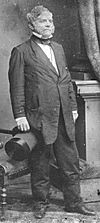
The first violence of the Civil War happened in Maryland. The federal government needed soldiers to move through Baltimore to protect Washington, D.C. On April 19, 1861, as Massachusetts soldiers were changing trains in Baltimore, a crowd of Southern supporters attacked them. People threw stones and bricks. In the chaos, soldiers fired into the crowd. Four soldiers and twelve civilians were killed.
This event inspired a Marylander named James Ryder Randall to write the poem "Maryland, My Maryland". This poem, which later became the state song, encouraged Marylanders to leave the Union. Confederate bands would play this song when they entered Maryland during the war.
After the riot, Baltimore's mayor and Governor Thomas Holliday Hicks asked President Lincoln to send troops around Baltimore, through Annapolis, to avoid more fighting. Governor Hicks and the mayor even ordered the destruction of railroad bridges leading into Baltimore from the North. This was done to stop more Union soldiers from coming through the city. For a short time, it seemed like Maryland might join the Confederacy. However, Lincoln promised the troops were only for defending Washington, D.C., and agreed to reroute them.
Maryland's Choice: Union or Confederacy?
Despite some support for the Confederacy, Maryland did not leave the Union. Many important citizens, including Richard Sprigg Steuart, urged Governor Hicks to call the state legislature to vote on secession. On April 22, Governor Hicks announced that the state legislature would meet in Frederick, Maryland, a town that strongly supported the Union.
The Maryland General Assembly met in Frederick and voted against secession by a large margin (53 to 13). They said they did not have the power to make such a decision. They also asked Lincoln to remove Union troops from Maryland and did not want to reopen rail links with the North. They wanted to avoid being part of a war against their Southern neighbors.
Martial Law in Maryland
On May 13, 1861, Union General Benjamin Butler entered Baltimore with 1,000 soldiers. He took control of Federal Hill, aiming cannons at the city. Butler declared martial law, meaning the military took control. This was done to prevent Maryland from helping the South and to ensure Union troops could move freely through the state.
Union soldiers were stationed throughout Maryland. People who supported the Confederacy or criticized Lincoln were arrested. Baltimore's mayor, city council, and police leaders were arrested and held at Fort McHenry without charges. One of these arrests led to a famous legal case called Ex parte Merryman. Chief Justice Roger B. Taney ruled that President Lincoln could not suspend habeas corpus without Congress's permission. However, Lincoln ignored this ruling.
Newspapers in Maryland that criticized Lincoln were shut down, and their owners were arrested. In September 1861, about one-third of the members of the Maryland General Assembly were arrested. This was because federal officials worried they might try to take the state out of the Union or stop the war effort.
Marylanders Fighting on Both Sides
Even though Maryland stayed in the Union, many Marylanders fought for both sides. More Marylanders joined the Union army, but thousands crossed the Potomac River into Virginia to fight for the Confederacy. These Confederate Marylanders formed units like the "Maryland Line" in the Army of Northern Virginia. They mostly came from the southern and eastern parts of the state. Northern and western Maryland provided more soldiers for the Union.
About 4,000 Marylanders are estimated to have fought for the Confederacy. However, many more Marylanders fought for the Union. The official records show that nearly 34,000 white Marylanders joined the Union Army, and over 8,700 African Americans from Maryland joined the United States Colored Troops.
One important Union regiment was the 2nd Maryland Infantry. Another was the 4th United States Colored Troops, whose Sergeant Major, Christian Abraham Fleetwood, received the Medal of Honor for his bravery.
Key Battles in Maryland
Marylanders Fight Each Other
Because Maryland was so divided, Marylanders sometimes fought against each other. On May 23, 1862, at the Battle of Front Royal, the Confederate 1st Maryland Infantry, CSA fought against the Union 1st Regiment Maryland Volunteer Infantry. This was a unique event in American history where two regiments from the same state, with the same number, fought each other. After the battle, many soldiers recognized former friends and even family members among the prisoners.
In September 1862, Confederate soldiers entered Frederick, Maryland. A Marylander fighting for the Confederacy, Colonel Bradley Tyler Johnson, hoped his fellow Marylanders would join them. But not many new recruits came forward. This might have been because of Union support in the area or because the Confederate army looked tired and worn out.
"Bloody Antietam"
One of the deadliest battles of the Civil War was the Battle of Antietam, fought on September 17, 1862, near Sharpsburg, Maryland. This battle was the end of Confederate General Robert E. Lee's first invasion of the North. Lee's army of about 40,000 men had entered Maryland after a victory in Virginia.
Union General George B. McClellan's army of 87,000 men moved to stop Lee. A Union soldier found a copy of Lee's battle plans, which showed that Lee had divided his army. This was a huge advantage for the Union, but McClellan waited before acting on this information.
The armies met near Antietam Creek. Both sides suffered terrible losses. The Union had over 12,400 casualties, with more than 2,100 dead. The Confederates had over 10,300 casualties, with more than 1,500 dead. More Americans died in battle on this single day than on any other day in U.S. military history.
Even though the battle didn't have a clear winner on the battlefield, it was a major victory for the Union strategically. It forced Lee to retreat from the North. This victory also gave President Lincoln the chance to issue the Emancipation Proclamation on January 1, 1863. Lincoln had wanted to issue this proclamation earlier, but he needed a Union victory to make it effective. The Battle of Antietam also likely stopped France and Great Britain from recognizing the Confederacy as an independent nation.
March to Gettysburg
In June 1863, General Lee's army again moved north into Maryland. A Marylander fighting for the Confederacy, George H. Steuart, was so happy to be back in his home state that he reportedly kissed the ground. However, his joy was short-lived. Steuart's brigade suffered heavy losses at the Battle of Gettysburg (July 1–3, 1863) in Pennsylvania. This battle was a major turning point in the war, and the Confederate army never fully recovered.
Battle of Monocacy
In 1864, another battle took place in Maryland, though it was smaller. The Battle of Monocacy was fought on July 9, near Frederick, Maryland. Confederate forces led by Lt. Gen. Jubal Early fought Union troops led by Maj. Gen. Lew Wallace. The Confederates won the battle, but Wallace's forces delayed Early for almost a full day. This delay was crucial because it gave the Union enough time to send reinforcements to defend Washington, D.C.
Prisoners of War
The federal government set up a large prison camp at Point Lookout State Park in St. Mary's County, Maryland. Thousands of Confederate soldiers were held there, often in difficult conditions. Between 1863 and 1865, nearly 4,000 of the 50,000 Southern soldiers held at Point Lookout died.
The town of Parole, near Annapolis, Maryland, became a camp where prisoners of war waited to be exchanged in the early years of the war. About 70,000 soldiers passed through Camp Parole. However, in 1864, General Ulysses S. Grant ended the system of prisoner exchanges.
Slavery and Freedom in Maryland
Many Marylanders who supported the Union did not initially want to end slavery in Maryland or the Confederacy. In March 1862, the Maryland Assembly stated that the war was only about bringing the Southern states back into the Union, with their constitutional rights unchanged.
Because Maryland had not left the United States, it was not included in President Lincoln's Emancipation Proclamation of January 1, 1863. This proclamation only declared enslaved people in the rebelling states to be free. However, in 1864, before the war ended, Maryland held a special meeting to create a new state constitution.
The 1864 Constitution and Ending Slavery
The Maryland Constitution of 1864 finally outlawed slavery in Maryland. This new constitution was strongly supported by Unionists who had gained control of the state government. Article 24 of the constitution officially ended slavery.
The new constitution also made it harder for Southern sympathizers to hold public office. It changed how the Maryland General Assembly was set up, reducing the power of counties with large former enslaved populations. The constitution was approved by a very close vote on October 13, 1864. Union soldiers from Maryland voted overwhelmingly in favor of it, which helped it pass.
The new constitution took effect on November 1, 1864. This made Maryland the first Union slave state to abolish slavery during the war. While it freed enslaved people, it did not immediately give them equal rights. For example, only white men could vote. Slavery was finally outlawed across the entire United States with the Thirteenth Amendment to the United States Constitution in December 1865. Maryland ratified this amendment quickly, on February 3, 1865.
However, Maryland's legislature refused to approve the Fourteenth Amendment to the United States Constitution, which gave citizenship rights to former enslaved people, and the Fifteenth Amendment to the United States Constitution, which gave African American men the right to vote. The right to vote was eventually extended to non-white men in the Maryland Constitution of 1867, which is still in effect today.
Lincoln's Assassination
Even after the war, strong feelings remained. On April 14, 1865, the actor John Wilkes Booth, a Marylander, assassinated President Abraham Lincoln at Ford's Theatre in Washington, D.C. After shooting Lincoln, Booth shouted "Sic semper tyrannis" ("Thus always to tyrants"). Booth then fled into Southern Maryland, where he was helped by people who supported the South. He was eventually found and killed in Virginia a week later.
In a letter, Booth explained his actions, saying he believed the South was right and that slavery was a "blessing." He also questioned why states were not allowed to leave the Union.
Maryland's War Legacy
Most Marylanders fought for the Union. However, after the war, several memorials were built in Maryland to honor the Confederacy. These included monuments in Baltimore to Confederate women and soldiers. Baltimore also had monuments to Robert E. Lee and Stonewall Jackson, which were removed in 2017. A home for retired Confederate soldiers in Pikesville, Maryland, was open from 1888 to 1932.
There is a Confederate monument in Rockville, Maryland, and another in Easton, Maryland. Maryland also has three chapters of the Sons of Confederate Veterans.
The war left a legacy of strong political feelings. Democrats were sometimes linked to "treason and rebellion" by their opponents. Democrats then called themselves the "Democratic Conservative Party," and Republicans called themselves the "Union" party to distance themselves from extreme views.
The strong actions Lincoln took to keep Maryland in the Union, such as arresting members of the state legislature, were controversial. These actions were even ruled unconstitutional by Maryland native Chief Justice Roger Taney. The lyrics of the former Maryland state song, Maryland, My Maryland, also reflect this anger, calling Lincoln a "despot" and a "tyrant."


